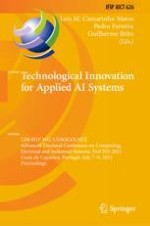2021 | Book
Technological Innovation for Applied AI Systems
12th IFIP WG 5.5/SOCOLNET Advanced Doctoral Conference on Computing, Electrical and Industrial Systems, DoCEIS 2021, Costa de Caparica, Portugal, July 7–9, 2021, Proceedings
Editors: Prof. Dr. Luis M. Camarinha-Matos, Pedro Ferreira, Guilherme Brito
Publisher: Springer International Publishing
Book Series : IFIP Advances in Information and Communication Technology
